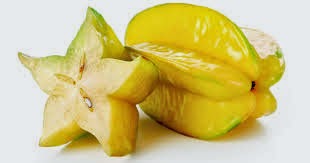wwwhealthydailymail.com Star fruit is a small, bushy evergreen tree that grows very well under hot, humid, tropical conditions. The plant bears small lilac color, bell-shaped flowers in clusters, which subsequently develop into oblong shaped fruits with characteristic five angled edges (sides or ribs) that appear like a starfish in cross sections. Both sweet and sour varieties begin to yield under cultivable orchards, and ready for harvesting when the plants reach about 3-4 years old.
Read more health news in www.healthydailymail.com also:
Benefits of star fruit
- Star fruit is one of the very low calorie exotic fruits. 100 g fruit just provides 31 calories, which is much lower than for any other popular tropical fruits. Nonetheless, it has an impressive list of essential nutrients, antioxidants, and vitamins required for well-being.
- The fruit along with its waxy peel provides a good amount of dietary fiber. Fiber helps prevent absorption of dietary LDL cholesterol in the gut. The dietary fibers also help protect the mucous membrane of the colon from exposure to toxic substances by binding to cancer-causing chemicals in the colon.
- Star fruit contains good quantities of vitamin-C. Vitamin C is a powerful natural antioxidant. 100 g of fresh fruit provides 34.7 mg or 57% of daily-required levels of vitamin C. In general, consumption of fruits rich in vitamin C helps the human body develop resistance against infectious agents and scavenge harmful, pro-inflammatory free radicals from the body.
- Star fruit is rich in antioxidant phyto-nutrients polyphenolic flavonoids. Some of the important flavonoids are quercetin, epicatechin, and gallic acid. Total polyphenol contents (Folin assay) in this fruit are143 mg/100 g. These compounds help protect from deleterious effects of oxygen derived free radicals by warding them off the body.
- In addition, the fruit is a good source of B-complex vitamins such as folates, riboflavin, and pyridoxine (vitamin B-6). Together, these vitamins help as co-factors for enzymes in metabolism as well as in various synthetic functions inside the body.
- It also contains small amount of minerals and electrolytes like potassium, phosphorus, and zinc and iron. Potassium is an important component of cell and body fluids helps controlling heart rate and blood pressure; thus, counters bad influences of sodium.

No comments:
Post a Comment